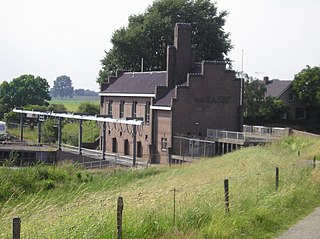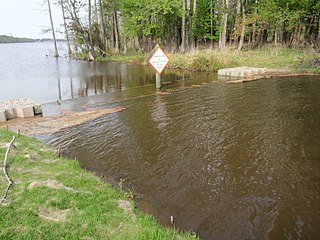Operation
The simplest siphon tubes are operated by simply filling the tube with water (by immersion in the canal, or other means), keeping one end in the canal and with the other end sealed, placing it in the area to be irrigated. The seal can then be removed and the water will siphon transferring the water from the submerged higher end to the lower end.
For tubes of up to 150mm diameter and several meters long, this is all easily undertaken by one person without any other tools. An effective seal is produced using a hand - with a rapid enough action there will be sufficient water in the tube to start the siphon effect.
Larger capacity siphon tubes may have mechanical means of sealing the ends, and allow for a pump to be used to prime the tube.
They can be used to either flood, or drain, as required.

Canals are waterways channels, or artificial waterways, for water conveyance, or to service water transport vehicles. They may also help with irrigation. It can be thought of as an artificial version of a river.

A vacuum pump is a device that removes gas molecules from a sealed volume in order to leave behind a partial vacuum. The first vacuum pump was invented in 1650 by Otto von Guericke, and was preceded by the suction pump, which dates to antiquity.

Irrigation is the application of controlled amounts of water to plants at needed intervals. Irrigation helps to grow agricultural crops, maintain landscapes, and revegetate disturbed soils in dry areas and during periods of less than average rainfall. Irrigation also has other uses in crop production, including frost protection, suppressing weed growth in grain fields and preventing soil consolidation. In contrast, agriculture that relies only on direct rainfall is referred to as rain-fed.

A lock is a device used for raising and lowering boats, ships and other watercraft between stretches of water of different levels on river and canal waterways. The distinguishing feature of a lock is a fixed chamber in which the water level can be varied; whereas in a caisson lock, a boat lift, or on a canal inclined plane, it is the chamber itself that rises and falls.

A flush toilet is a toilet that disposes of human excreta by using water to flush it through a drainpipe to another location for disposal, thus maintaining a separation between humans and their excreta. Flush toilets can be designed for sitting or for squatting, in the case of squat toilets. The opposite of a flush toilet is a dry toilet, which uses no water for flushing.

A coffee percolator is a type of pot used for the brewing of coffee by continually cycling the boiling or nearly boiling brew through the grounds using gravity until the required strength is reached.

A siphon is any of a wide variety of devices that involve the flow of liquids through tubes. In a narrower sense, the word refers particularly to a tube in an inverted "U" shape, which causes a liquid to flow upward, above the surface of a reservoir, with no pump, but powered by the fall of the liquid as it flows down the tube under the pull of gravity, then discharging at a level lower than the surface of the reservoir from which it came.

Pumping stations, also called a pumphouse in situations such as drilled wells and drinking water, are facilities including pumps and equipment for pumping fluids from one place to another. They are used for a variety of infrastructure systems, such as the supply of water to canals, the drainage of low-lying land, and the removal of sewage to processing sites. A pumping station is, by definition, an integral part of a pumped-storage hydroelectricity installation.

A flow control structure is a device that alters the flow of water in a stream, drainage channel or pipe. As a group these are passive structures since they operate without intervention under different amounts of water flow and their impact changes based on the quantity of water available. This includes weirs, flow splitters and proprietary-design devices that are used for stormwater management and in combined sewers.

The pumping of water is a basic and practical technique, far more practical than scooping it up with one's hands or lifting it in a hand-held bucket. This is true whether the water is drawn from a fresh source, moved to a needed location, purified, or used for irrigation, washing, or sewage treatment, or for evacuating water from an undesirable location. Regardless of the outcome, the energy required to pump water is an extremely demanding component of water consumption. All other processes depend or benefit either from water descending from a higher elevation or some pressurized plumbing system.

Thermosiphon is a method of passive heat exchange, based on natural convection, which circulates a fluid without the necessity of a mechanical pump. Thermosiphoning is used for circulation of liquids and volatile gases in heating and cooling applications such as heat pumps, water heaters, boilers and furnaces. Thermosiphoning also occurs across air temperature gradients such as those utilized in a wood fire chimney or solar chimney.

Heron's fountain is a hydraulic machine invented by the 1st century AD inventor, mathematician, and physicist Heron of Alexandria.

Nagarjuna Sagar Dam is a masonry dam across the Krishna river at Nagarjuna Sagar which straddles the border between Guntur district, Andhra Pradesh and Nalgonda district, Telangana. Constructed between 1955 and 1967, the dam created a water reservoir with gross storage capacity of 11.472 billion cubic metres. The dam is 590 feet (180 m) tall from its deepest foundation and 0.99 miles (1.6 km) long with 26 flood gates which are 42 feet (13 m) wide and 45 feet (14 m) tall.

Lift irrigation is a method of irrigation in which water is not transported by natural flow, but is lifted with pumps or surge pools etc.

The harsh project is one of the largest irrigation projects in the Indian state of Maharashtra. It is a multipurpose project. The water is mainly used to irrigate agricultural land in the drought-prone Marathwada Region region of the state. It also provides water for drinking and industrial usage to nearby towns and villages and to the municipalities and industrial areas of Aurangabad and Jalna district. The surrounding area of the dam has a garden and a bird sanctuary.

Surface irrigation is where water is applied and distributed over the soil surface by gravity. It is by far the most common form of irrigation throughout the world and has been practiced in many areas virtually unchanged for thousands of years.

Yarrow boilers are an important class of high-pressure water-tube boilers. They were developed by Yarrow & Co. (London), Shipbuilders and Engineers and were widely used on ships, particularly warships.
Irrigation is the artificial exploitation and distribution of water at project level aiming at application of water at field level to agricultural crops in dry areas or in periods of scarce rainfall to assure or improve crop production.
This article discusses organizational forms and means of management of irrigation water at project (system) level.
Water resources management in modern Egypt is a complex process that involves multiple stakeholders who use water for irrigation, municipal and industrial water supply, hydropower generation and navigation. In addition, the waters of the Nile support aquatic ecosystems that are threatened by abstraction and pollution. Egypt also has substantial fossil groundwater resources in the Western Desert.

Micro-irrigation, also called localised irrigation, low volume irrigation, low-flow irrigation, or trickle irrigation is an irrigation method with lower pressure and flow than a traditional sprinkler system. Low volume irrigation is used in agriculture for row crops, orchards, and vineyards. It is also used in horticulture in wholesale nurseries, in landscaping for civic, commercial, and private landscapes and gardens, and in the science and practice of restoration ecology and environmental remediation.

















